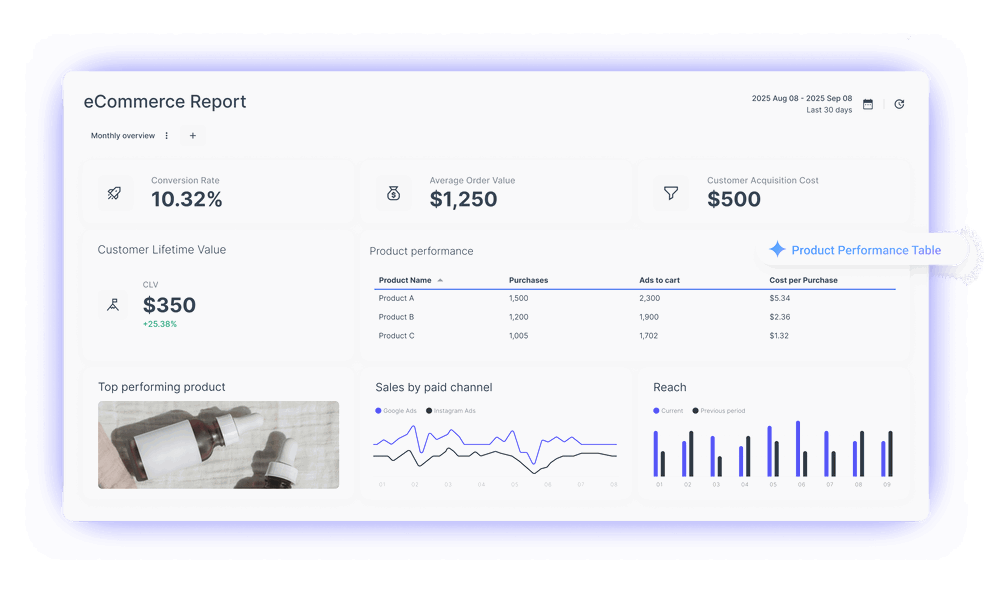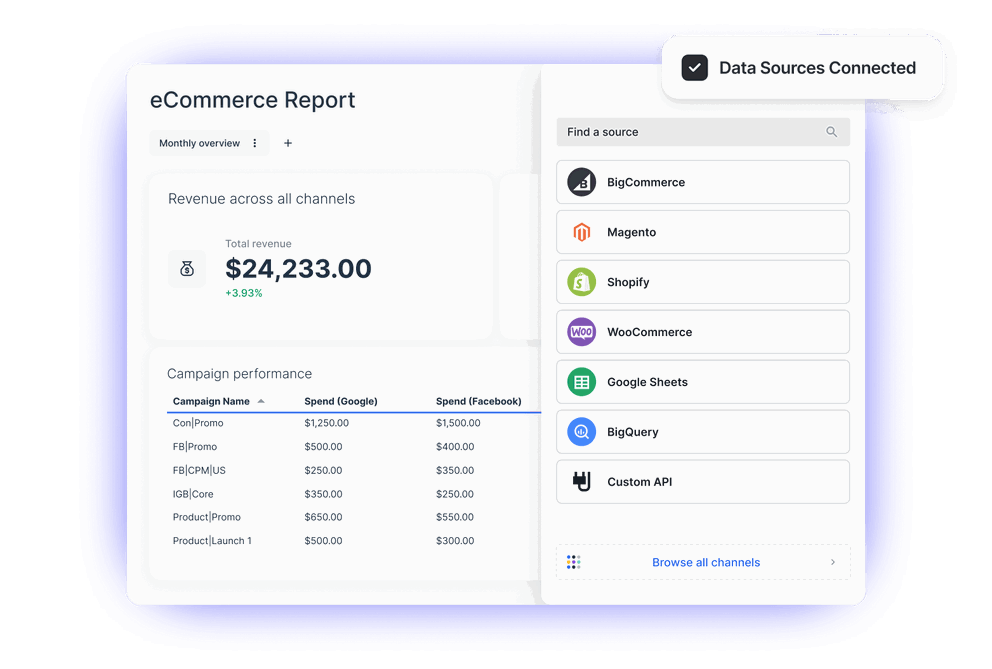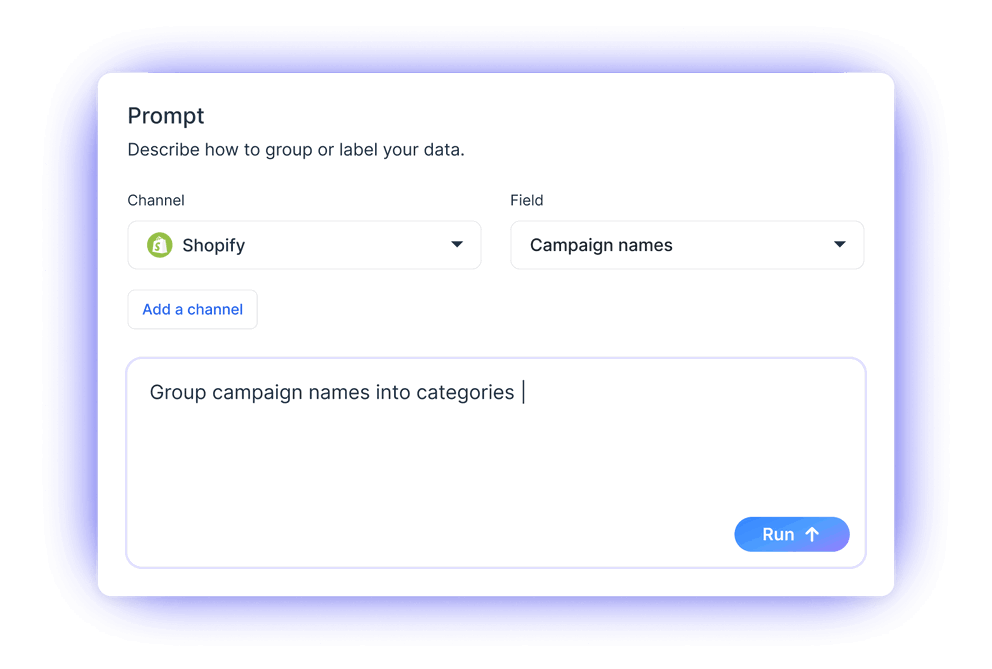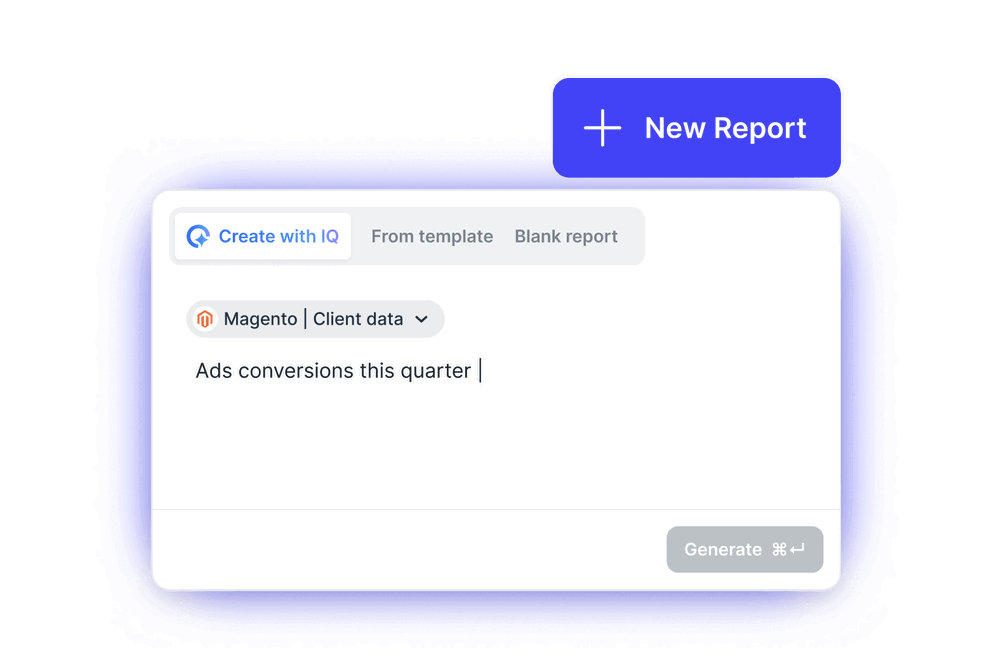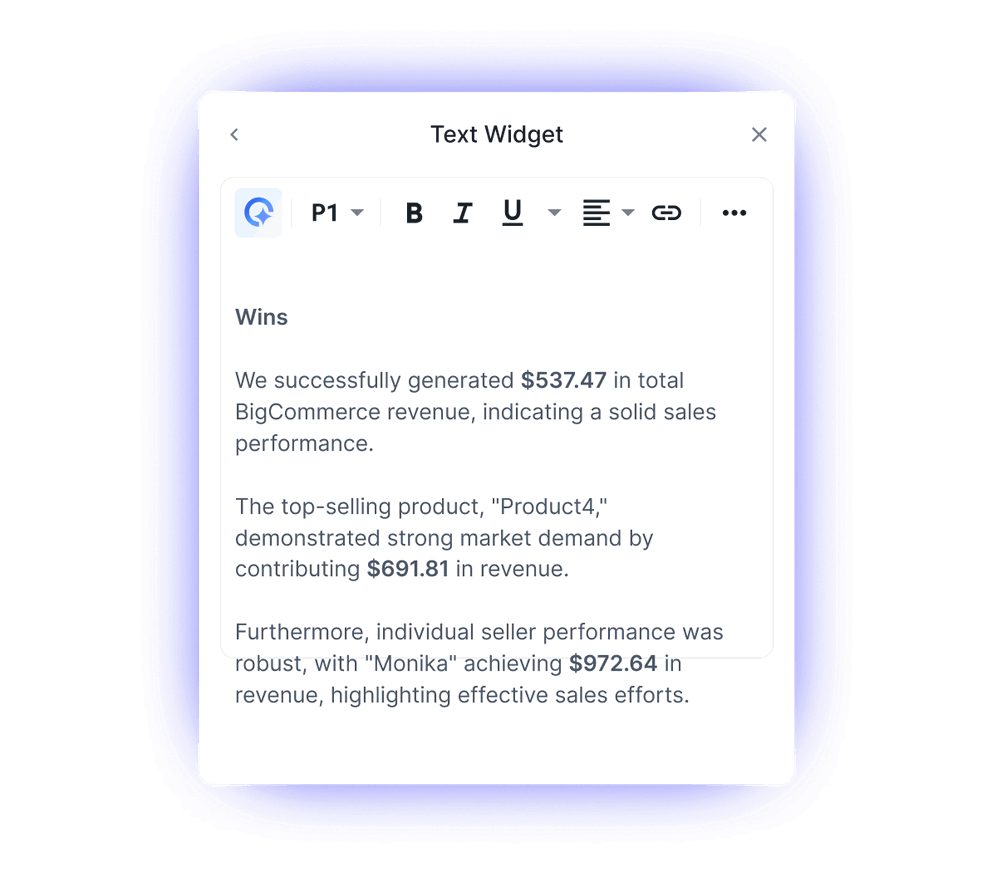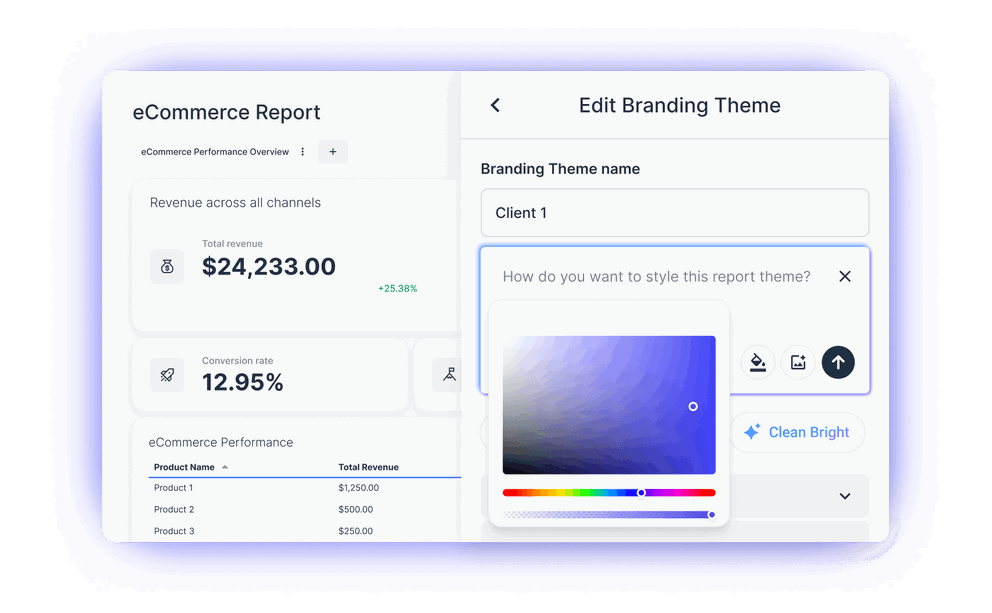What is eCommerce analytics software?
Most eCommerce business owners agree that data is key to better decisions for your business. But the real challenge is organizing and visualizing sales data from multiple platforms in a way that leads to actual business insights.
E-commerce analytics tools solve this by:
1. Connecting to each data source (e.g., Shopify, Facebook Ads, TikTok, Klaviyo).
2. Organizing the data so everyone can understand it and get insights.
3. Visualizing the data in reports and dashboards—complemented with widgets, charts, and graphs.
4. Sharing the reports via scheduled emails, PDFs, or shareable links
Tools like Whatagraph expand on this by letting you create reports and widgets simply from a prompt.
How do I choose the best eCommerce reporting tools?
When choosing an eCommerce reporting tool, here are the features you should prioritize:
#1. Integrations with all your eCommerce platforms
First and foremost, your eCommerce reporting tool needs to integrate with all the eCommerce platforms you’re using so you can seamlessly visualize this data in reports.
At Whatagraph, for example, we offer integrations with these eCommerce platforms:
- BigCommerce
- Magento
- Shopify
- WooCommerce
Plus, you can also bring in custom data via Google Sheets or BigQuery.
But having the key integrations isn’t enough on its own—the data integrations need to be reliable and stable.
Most eCommerce marketers use a combination of a third-party connector + a visualization tool like Looker Studio to get reports, but the third-party connectors are notorious for breaking often.
One of our customers, Tanja Keglić, Performance Marketing Manager at Achtzehn Grad agency was using a combination of Supermetrics (third-party connector) and Looker Studio but this setup was riddled with issues.
Supermetrics connectors frequently broke, sources failed to load properly, and Tanja had to either waste time fixing them herself or contact Support for help.
“It’s such a pain to reconnect a lot of sources and accounts—and it takes so much time, which you don’t have when you want a quick report,” Tanja shared.
You don’t want to run into a situation like this, which is why it’s truly important to choose an eCommerce reporting tool that comes with native integrations that are built and maintained in-house by data engineers.
This is exactly what Whatagraph offers.
Our integrations are built, managed, and maintained by our data engineers, which means they’re more reliable and seamless. And you won’t have to waste time “baby sitting” data connections yourself or waiting for Customer Support to get back to you.
The Whatagraph platform itself has an uptime of 99.95%, which means system-wide outages are very rare. In fact, we even have a 24/7 emergency alert that will wake up our engineers to quickly resolve issues, if there are any.
When Tanja switched to Whatagraph, the connection issues were solved.
We don't have any connection issues on Whatagraph at all. We just connected the platforms once, and that was it. Whatagraph is also very, very fast when loading the data.
#2. Easy to use
This is an important one. If your eCommerce reporting tool is clunky to use, you’ll spend hours building reports each day, only to get incomplete insights.
Make sure your eCommerce reporting tool has:
- Simple but advanced customization options
- An intuitive interface that everyone in your team understands
- Automated data connections that you can set up in just a few clicks
- Pre-made templates, drag-and-drop widgets, and graphs to build reports
- AI tools to speed up creating reports, styling, organizing data, and more
- Responsive customer support for getting help whenever you need it
- Ability to scale up as you need
At Whatagraph, ease of use is at the core of our product. For example, see what one of our users, Elvira Danielsson, Digital Marketing Specialist from Ampilio, said:
We love the drag-and-drop function on Whatagraph and the simple layout of reports. It's easy for anyone to start creating reports, and even non-tech savvy people can start using it.
Plus, with Whatagraph IQ—a suite of AI features to create, style, and understand reports—you don’t even need drag-and-drop widgets or report templates anymore.
You can just tell us what kind of report, widget, or tab you want us to create and we’ll do it for you automatically.
Plus, you can also get Whatagraph IQ to:
- Create custom blends, metrics, and dimensions
- Write out performance summaries directly in your reports in 18 different languages and four formats
- Ask any question you want about your eCommerce data and get actionable insights back in seconds
#3. Highly customizable
Numbers alone don’t tell a story. Your eCommerce reporting tool needs to be capable of adjusting to your specific goals.
With Whatagraph, for example, you can:
- Change the orientation (landscape vs. portrait)
- Add headers, body text, footers, and button texts
- Drag-and-drop pre-made widgets
- Insert or delete rows anywhere
- Write subject lines
Plus, for each widget, you can:
- Write custom titles and descriptions
- Hide or show footers
- Choose icons from our icon library
- Change the currency display
- Choose custom colors
And that’s not all. You can add full white-labeling to your reports:
- Upload your own or your client’s logo
- Choose from pre-made color schemes or apply your own by uploading your brandbook
- Add comments, boxes, and headers
- Personalize the cover pages
When we say you can customize all parts of your report, we truly mean it.
With Whatagraph IQ helping you create new widgets and styles in seconds, you'll spend less time creating reports and more time actually analyzing and implementing your data.
#4. Time-saving
Not only should your eCommerce reporting tool offer deep customization, but also time-saving features.
This means prioritizing tools with:
✅ Powerful AI features for creating, styling, and analyzing reports
✅ Report templates, so you don’t have to start from scratch
✅ Drag-and-drop widgets to speed up report building
✅ Linked reports for editing multiple reports at once
✅ Automated emails that you can schedule to send out to specific people at specific days, times, and frequency
The difference between a highly manual and automated reporting workflow is huge. For example, Peak Seven agency saved a whopping 63 hours per month on reporting and $9K+ for each client per month by adopting Whatagraph, which ticks all of the boxes above.
#5. Responsive customer support
No matter how easy an eCommerce reporting tool is, there might still come a time when you need help.
In moments like these, having access to a reliable support team is everything.
For Whatagraph users, this is good news as all users have access to:
✔️ Live chat support that replies within 4 minutes and resolves most issues within 4 hours
✔️ A dedicated Customer Success Manager who helps with:
- Setting up data connections
- Migrating data from your current platform (if you have one)
- Organizing your campaigns and data
- Walking you through new features and updates
Customer support is often the area users love most about Whatagraph. For example, see what Kim Strickland, Digital Marketing Specialist at Peak Seven agency, said:
I've joked about this often—with Whatagraph, we're not paying for a reporting system. We're paying for customer support. There's a level of dedication from the Whatagraph team that you don't often experience anywhere else.
What's the best e-commerce software for analytics and reporting?
If you’re an eCommerce or a small business owner who wants to get data-driven insights from eCommerce reports, Whatgraph is arguably one of the best choices.
Here’s what makes Whatagraph stand out:
- 55+ native integrations: Access our 55+ integrations, including with Shopify, BigCommerce, Meta, TikTok, Klaviyo, Google Analytics, and more
- Reports from a single prompt: Just tell Whatagraph the type of report you want, or use one of our pre-made eCommerce report templates and track key metrics.
- Style reports in seconds: Upload a screenshot of your brandbook or use a simple prompt, and Whatagraph will apply styling to your marketing reports instantly.
- Ask our AI anything: Use our AI chatbot to ask questions about your data. Get real-time insights without digging through
- AI-generated summaries: Get AI-generated summaries, wins, recommendations, and next actions in plain language—easy to understand by your colleagues and clients.
- Blend and clean your data: Create custom blends, dimensions, and metrics by just explaining to us the way you want to organize your data. No complex formulas or technical know-how needed.
- Share reports how you want: Share your reports by scheduling an email, exporting as PDF or Excel, or sharing a live dashboard link.
Talk to us to get started.
